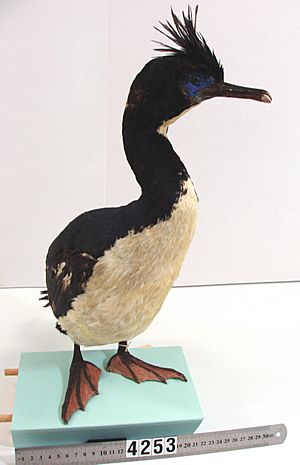Bounty shag facts for kids
Quick facts for kids Bounty shag |
|
|---|---|
 |
|
| Specimen of Leucocarbo ranfurlyi held at the Auckland Museum. | |
| Conservation status | |
| Scientific classification | |
| Genus: |
Leucocarbo
|
| Species: |
ranfurlyi
|
| Synonyms | |
|
Phalacrocorax ranfurlyi |
|
The Bounty shag (Leucocarbo ranfurlyi) is a special type of cormorant. It is also called the Bounty Island shag. This bird belongs to the cormorant family, known as Phalacrocoracidae.
You can only find these shags on the tiny, faraway Bounty Islands. These islands are about 670 kilometers (416 miles) southeast of New Zealand. The Bounty shag loves open seas and rocky coastlines.
In 2005, scientists counted 618 Bounty shags. About 410 of these were adult birds. Their population seems to have stayed about the same since then. Some bird experts place this species in the Leucocarbo group. Others put it in the Phalacrocorax group.
Contents
What the Bounty Shag Looks Like
The Bounty shag is a large bird, about 71 centimeters (28 inches) long. It has a striking black and white body.
Colors and Features
- Its head, back of the neck, lower back, and rump are black.
- These black parts have a shiny, metallic blue look.
- Its belly and chest are white.
- The bird has pink feet.
- White patches on its wings look like a bar when the wings are folded.
- Unlike some other birds, it does not have fleshy growths called caruncles on its face.
Sounds the Bounty Shag Makes
Male Bounty shags make calls only when they are performing special displays. These displays are often part of their mating rituals.
Protecting the Bounty Shag
The IUCN says the Bounty shag is a Vulnerable animal. This means it could be in danger of disappearing.
Why It's Vulnerable
The Bounty shag's population is very small. Also, it only lives in one small area. This makes it sensitive to unexpected problems or human actions.
How They Are Protected
Luckily, the Bounty Islands are a nature reserve. This means they are protected. There are no animals brought in by humans, like rats or cats, that could harm the birds.
In 1998, the islands became a UNESCO World Heritage Site. This is a special place recognized for its natural importance. The islands have no people living on them and are rarely visited. This means humans do not bother the birds very much.
See also
 In Spanish: Cormorán de las Bounty para niños
In Spanish: Cormorán de las Bounty para niños


